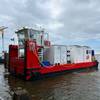While visiting several hundred future Department of Homeland Security employees in Miami, Secretary Ridge highlighted the Department's strategic goals for building a nation where Americans are protected from the evil of terrorism.
One of the top priorities is to integrate specific departmental functions to enhance efficiencies and create greater accountability in one seamless border service. To accomplish this, today President Bush submitted to Congress a modification to the Department of Homeland Security Reorganization Plan which establishes the organizational framework for the Department's Border and Transportation Security mission.
The Congress recognized the potential need to reorganize and included a statutory provision in the Homeland Security Act of 2002 so the Department could submit such modifications. The modification submitted today presents a structural change, but does not consolidate, discontinue, or diminish transferred agencies' current operations in the field.
Border and Transportation Security Reorganization
Our country shares a 5,252-mile border with Canada and a 1,989-mile border with Mexico, with a combined total of more than 300 international land-based ports-of-entry. Intertwined with our borders is a maritime system that includes 95,000 miles of coastline and navigable waterways and a global transportation network - with over 300 seaports, 429 commercial airports and several hundred thousand miles of highways and railroads - that connects to virtually every community in America.
Today, border security and inspections are performed by three separate agencies: The Immigration and Naturalization Service (Department of Justice) including the Border Patrol, the United States Customs Service (Department of Treasury) and the Animal and Plant Health Inspection Services (Department of Agriculture).
Different priorities and divergent policies coupled with various leadership structures, has led to inconsistent inspections and lapses of information. The Department of Homeland Security was established to unite the incoming agencies in the mission of protecting the homeland; yet more must be done.
The President's modification will enable Department leadership to establish coherent policies for the incoming agencies and will provide the opportunity to reduce duplication of efforts and to ensure improved information-sharing.
The President proposes this modification to facilitate the Border and Transportation Security Directorate's ability to meet the strategic goals of improving border security, while at the same time facilitating the unimpeded and reliable flow of commerce and people across our borders and through our ports.
The Department of Homeland Security will bring together the various border agencies into the Bureau of Customs and Border Protection and rename the Bureau of Border Security (as indicated in the Homeland Security Act of 2002) the Bureau of Immigration and Customs Enforcement to refocus homeland security inspection and investigation functions. The bureaus will be organized in the Department's Border and Transportation Directorate.
These two new bureaus will break down barriers to communication and provide a direct line of authority to the Department's headquarters and give homeland security employees a clear mission. It will join the investigators with the investigators and the inspectors with the inspectors to capitalize on expertise and resources.
Bureau of Customs and Border Protection
This new Bureau will bring together approximately 30,000 employees including 17,000 inspectors in the Agricultural Quarantine Inspection program, INS inspection services, Border Patrol and the Customs Service, including canine enforcement officers. It will be headed by the Commissioner of Customs who will report to the Under Secretary for Border and Transportation Security.
The Bureau will focus its operations on the movement of goods and people across our borders. Over the next several months, we will work with employees and other stakeholders to ensure that the goal of consistent inspection procedures and greatly improved communication and information sharing create the highest levels of service and accountability.
Bureau of Immigration and Customs Enforcement
This Bureau will bring together the enforcement and investigation arms of the Customs Service, the investigative and enforcement functions of Immigration and Naturalization Service and the Federal Protective Services. The reorganization involves approximately 14,000 employees, including 5,500 criminal investigators, 4,000 employees for immigration and deportation services and 1,500 Federal Protective Service personnel that will focus on the mission of enforcing the full range of immigration and customs laws within the interior of the United States in addition to protecting specified federal buildings. The air and marine enforcement functions of the Customs Service will also be a part of this bureau.
By unifying the previously fragmented investigation functions, the new Bureau will enhance information sharing with the Federal Bureau of Investigation and develop stronger relationships with the U.S. Attorneys' Office.
This Bureau will be headed by an Assistant Secretary who will report directly to the Undersecretary for Border and Transportation Security and will advise the Under Secretary on any policy or operation of the Bureau that may affect the Bureau of Citizenship and Immigration Services.
The Bureau of Citizenship and Immigration Services, a separate bureau that was created by the Homeland Security Act, will allow the Department to greatly improve the administration of benefits and immigration services for applicants by focusing exclusively on immigration and citizenship services.
The Transportation Security Administration will build on its success of hiring, training and deploying new professional federal screeners to our nation's 429 commercial airports and continue to protect and secure the nation's transportation systems. TSA will benefit from the reorganization by enhanced information sharing with the new BTS bureaus.
Timing and Funding
This new structure will be implemented when the agencies move to the Department of Homeland Security on March 1, 2003. However, full integration of the new agencies will be a collaborative effort undertaken over the next few months between employees, stakeholders, and the DHS senior leadership.
Funding to effectively implement the reorganization plan as well as support the Department's other key initiatives and missions will be included in the President's FY 2004 budget request.
Secretary Ridge also announced that the President is committed to funding Department of Homeland Security efforts at the appropriate levels, so that, as he said in his State of the Union address, we will be ready to "answer every danger and every enemy that threatens the American people."
Specifically the President will request $41.3 billion for homeland defense and security. The Department of Homeland Security's funding request of $36.2 billion represents a 64 percent increase in funding and resources from 2002.
Subscribe for
Maritime Reporter E-News
Maritime Reporter E-News is the maritime industry's largest circulation and most authoritative ENews Service, delivered to your Email five times per week










